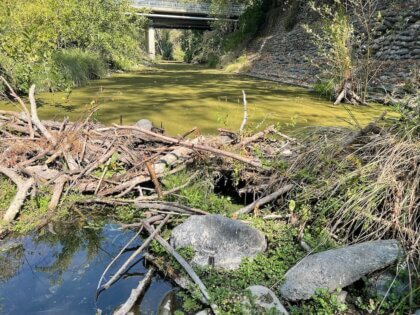 Teri Shore is a long-time environmentalist and journalist who has lived in Sonoma Valley for more than three decades. She is an avid hiker, backpacker, and wilderness advocate. As an environmental campaigner, she championed winning campaigns to preserve greenbelts and open space, create safe havens for endangered species, and clean up marine pollution for nonprofit advocacy groups.
Teri Shore is a long-time environmentalist and journalist who has lived in Sonoma Valley for more than three decades. She is an avid hiker, backpacker, and wilderness advocate. As an environmental campaigner, she championed winning campaigns to preserve greenbelts and open space, create safe havens for endangered species, and clean up marine pollution for nonprofit advocacy groups.
Beavers are an ecosystem

The beaver dam is back on Sonoma Creek in Maxwell Farms Regional Park. It was washed away during last season’s storms. Last time I looked, the intertwined limbs and branches were holding back the low water flows as summer turned to fall. I also found gnawed wood chips and pieces as evidence of powerful incisors. No beavers in sight, though.
While I’ve never spotted an actual beaver in Sonoma Valley, I’ve seen several dams, including one way down along the creek next to the road to Wingo. The beavers on Fryer Creek in downtown Sonoma have been in the news. There the creek was engineered to allow the beavers to do their thing without flooding nearby homes.
A few years back, beavers caught munching on wine grape vines raised a ruckus. Back then vineyard owners and other farmers were allowed to remove troublemaking beavers with a state depredation permit. The public outcry was tremendous. Under new state rules adopted this summer, beavers are being given another chance. Now non-lethal methods to deter beavers are required to be used before landowners can be issued to kill a beaver. Trapping or relocation is not allowed.
Today beavers are no longer considered a nuisance in California. We are now realizing, or perhaps remembering, that they are a keystone species that provide multiple environmental benefits to the world. The California Department of Fish and Wildlife just launched a major new beaver restoration program to protect beavers and enhance their populations. That’s because beavers are not just an animal, but an ecosystem, according to the Bring Back the Beaver Campaign of the Occidental Arts and Ecology Center.
The dams and reservoirs that beavers build provide habitat for fish and frogs and many other aquatic species. The dams slow and store water where deer, coyotes, and birds can drink and bathe. River otters splash and feed upstream. Trees and plants take root and provide shade. As a result, the dams help with erosion control. New science also demonstrates that beaver dams can serve as wildfire buffers by increasing water tables and wetlands over a large area.
The beaver is the biggest rodent in North America. It is an herbivore that eats all kinds of plants as well as tree bark. Adults weigh 40 to 80 pounds. They live in tight knit family groups of two parents and young kits as well as yearlings and juveniles. The mating pair have only one litter per year and live an average of 12 years in the wild.
For a long time, beavers were missing from Sonoma Valley and California. Some experts believed that the beaver was never native to our area. Others agreed that beavers disappeared due to over-hunting. Local historian Arthur Dawson pointed out that “the impression that beavers were common in Sonoma County is supported by the fact that all our indigenous languages – Coast Miwok, Wappo and Pomo – have words for beaver.”
In any case, the beavers are definitely here.
In recent years, 209 beaver observations in Sonoma have been recorded on iNaturalist. I couldn’t find any data on current populations, but back in the 1950s, beavers were being reintroduced in parts of California by parachute! Yes, as bizarre as that sounds, that was the method used to return them to remote wild areas. The population was estimated at 1,300 at that time. Many of today’s beavers are related to those parachuting beavers.
What a wild Valley!
Photo credit: Sonoma Ecology Center






